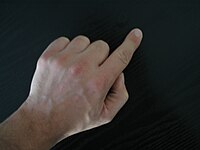
Photo from wikipedia
Objective The hands and fingers are frequently injured among children. Therefore, this study aimed to describe the epidemiological characteristics of hand and finger injuries among Japanese children and identify preventive… Click to show full abstract
Objective The hands and fingers are frequently injured among children. Therefore, this study aimed to describe the epidemiological characteristics of hand and finger injuries among Japanese children and identify preventive strategies. Methods This was a retrospective review of data of pediatric patients who visited the Kitakyushu City Yahata Hospital in Japan, between April 2018 and March 2019. All patients 15 years or younger who experienced hand and finger trauma were included. Data on age, sex, injured part, location of the incident, mechanism of injury, objects, diagnosis, consultation with specialists, treatments, and outcomes were collected and analyzed by classifying the participants based on age into the following 5 age groups: younger than 1, 1 to 2, 3 to 5, 6 to 10, and 11 to 15 years. Results A total of 554 patients were included in this study (male, 57.2%; median age, 4.5 years). The most commonly injured part of the hand was the index finger (22.4%), followed by the middle (18.9%) and ring (16.8%) fingers. A total of 111 patients (15.1%) had palm or dorsal hand injuries. Burn by touching hot objects at home was the leading cause of injuries to the palms during infancy, whereas door-related contusion and abrasion of the index, middle, and ring fingers were most common in preschool children. Sports-related fingertip fractures and sprains most frequently occurred in the thumb and little fingers of school children. Approximately half of the patients (53.3%) did not require any specific treatment. Most patients (98.2%) were treated at the outpatient department. Conclusions This study provides the epidemiology of age-specific hand and finger injuries among Japanese children. Therefore, the childhood hand and finger injury prevention strategy should focus on age as a characteristic.
Journal Title: Pediatric Emergency Care
Year Published: 2022
Link to full text (if available)
Share on Social Media: Sign Up to like & get
recommendations!